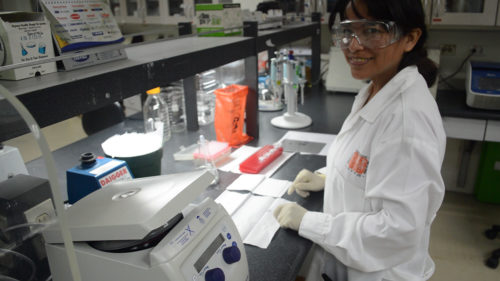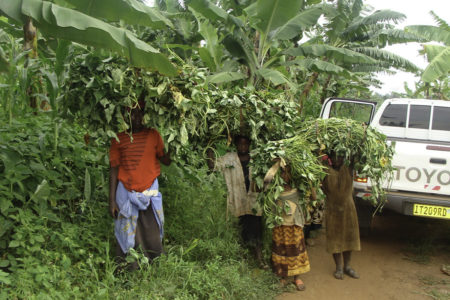
6 ways phytosanitation helps build and safeguard food security
Moving planting material between borders can fuel research, build food security, and help tackle the impact of climate change. Viruses and pests, however, can hitch rides on plants and packing materials. An infected plant transported from one area to another can introduce previously unknown diseases and wreck havoc on food systems. To avoid this threat organizations such as the International Potato Center (known as CIP for its acronym in Spanish) take steps, known as phytosanitation, to eliminate pathogens such as pest and disease before shipping.
Plant virologist, Dr. Jan Kreuze, shares with us six ways that phytosanitation helps to build and safeguard food security.
1) Eliminates the risk of introducing pathogens into new areas
When moving germplasm, following proper phytosanitation protocols is critical to help stop the spread of disease. A few years ago we saw Maize Lethal Necrosis decimate maize production in Africa where it hadn’t previously existed. First reported in Kenya in 2011, it has now spread throughout East and Central Africa. More recently the Fall Armyworm was first reported from West Africa in 2016 and has already spread all over the continent. Because these pathogens have no natural enemies in their new environments, they take root and spread like wildfire. Maize Lethal Necrosis Crop losses can reach a devastating 100 percent.
Smallholder farmers, in particular, rely on their harvests to not only feed their family but to use any surplus to pay for essentials such as education and healthcare. For them losing a harvest can lead to increased malnutrition, lost income, and increased susceptibility to disease and its consequences. Phytosanitation helps to prevent such outcomes.

2) Prevents the spread of already existing diseases
Viral transmission through seeds is minimal, but with potato and sweetpotato the planting material is part of the plant. Since the resulting plants are direct clones of their mother, everything is transmitted. The more infected clones grown in one area, the more viruses will accumulate. A farmer can unknowingly spread viruses by taking an infected clone from one site and planting it in another. Research and development organizations can stop this cycle by helping farmers access disease-free planting materials. Sometimes development organizations and researchers get frustrated because they feel that phytosanitation is costly and slows down the process of accessing planting materials for research and development, but the cost of not doing so could be devastating to an entire food system.

3) Gives farmers best possible planting material
At CIP we work with roots and tubers, vital food security crops for smallholder farmers worldwide. Because these crops are vegetatively propagated, they are also more susceptible to the build up of pathogens than seeds. Smallholder farmers often can’t identify a virus; they see that their crops are failing and they might attribute it to other factors such as too much sun and therefore not take the proper steps to eliminate the spread of disease. By providing planting materials that have undergone phytosanitation, we’re assuring that farmers have access to the best possible planting materials. Clean germplasm will not only produce more robust harvests and build the food security of the entire family, it also helps prevent disease accumulation by giving farmers an alternative to reusing infected planting materials. CIP also teaches farmers how to select the healthiest plant to use for planting the next season, i.e. how to manage their own phytosanitation, they can reduce the accumulation of disease and maintain yield from their own planting material for more growing seasons.
4) Diversifies and replenish the varieties farmers plant
When farmers use infected planting materials from one year to the next, over time the increasing viral load will significantly diminish crop yields. A loss in crop yields may even result in a farmer abandoning a particular variety. We’ve seen this happen in the Peruvian Andes, home to more than 3,000 varieties of native potatoes. For generations, traditional native potato farmers would harvest an average of 400 different varieties on one-hectare plots. Factors such as disease accumulation and climate change have prompted farmers to abandon certain varieties. Since its inception, CIP has been collecting and preserving native potato varieties and now helps to repatriate disease-free germplasm to Andean farming communities. In some cases native potato farmers are rediscovering the varieties, they ate as children, which had been lost or abandoned over the years. Helping to preserve and replenish this natural biodiversity benefits all humanity.
5) Fuels research
The exchange of clean germplasm between research organizations is imperative as we work to develop new varieties that are adapted to the ever-changing pressures of climate change. Each country faces unique challenges whether it is high salinity or cyclical drought. Throughout Africa, CIP is supporting the growth of National Agricultural Research Systems to develop varieties suited to the needs of their communities. Following proper phytosanitary measures helps facilitate and accelerate the sharing of germplasm that can fuel new varieties with desired traits such as heat tolerance or pest resilience. For example, CIP can house a collection of its sweetpotato and potato collections in Africa at the Kenya Plant Health Inspectorate Service (KEPHIS) because they follow the necessary international standards. We support them with the testing and treatment of these species. As a result, of this collaboration root and tuber germplasm can be moved more quickly and safely throughout the continent.
6) Helps jumpstart food systems in the aftermath of an emergency
One benefit of adhering to international phytosanitary standards is that if it is clean, pathogen-testing is not necessary on the receiving end of a shipment. This is particularly useful in the aftermath of a major disaster where a seed system may have been decimated. Helping farmers reestablish their food system quickly can diminish the need for of forced migration due to widespread food insecurity. Highly nutritious biofortified orange-fleshed sweetpotato is particularly suited for this as it is easy to plant, requires few inputs, and the leaves can be eaten as early as two months after planting, with the roots ready for consumption at just three months. After Cyclone Winston ravaged the island nation of Fiji, the CIP genebank was able to quickly send certified sweetpotato germplasm to help the Center for Pacific Crops and Trees (CePaCT) in their work to recover the agricultural sector. A total of 420 test tubes containing individual plants were sent. This shipment helped jumpstart agriculture in the region at a faster pace by helping CePaCT scale up with access to five times more planting materials. Months of growing time were saved as a result.
